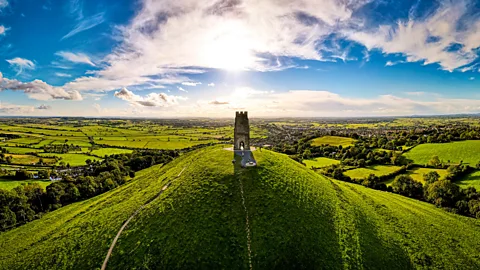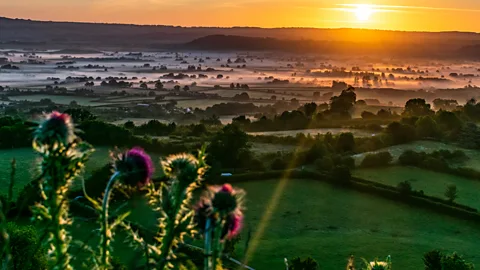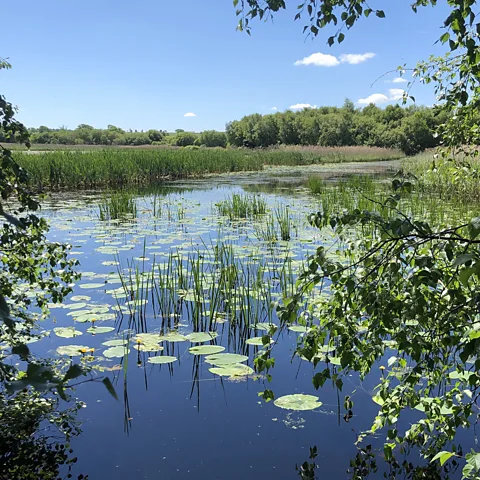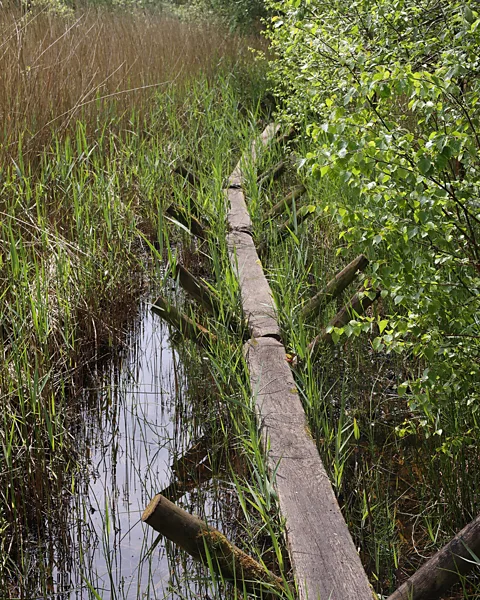The revival of Britain's myth-shrouded, sacred wetlands
 Getty Images
Getty ImagesLegends will always swirl around Glastonbury, but conservation projects like the Avalon Marshes point to a future that transcends the mythical and has real benefits for our planet.
The county of Somerset is England's mythical and historical heartland. Alfred the Great's military campaigns from the fortress of Athelney in the 9th Century were instrumental in the birth of the English nation; while the nearby ruins of Glastonbury Abbey contain a grassy grave claiming to be the resting place of the mythical King Arthur. Sites like Glastonbury Tor retain a mythical pull to this day, said by some to be places of great spiritual power.
The small, modern town of Glastonbury is full of bohemian shops that trade on the area's rich corpus of folklore. In one of them, The Hollow Hills Bookshop, I picked up a work by British occultist Dion Fortune – 1934's Avalon of the Heart. The title alludes to the identification of Glastonbury with the Isle of Avalon from Arthurian mythology (a money-making hoax by the abbey's monks, according to archaeologists), and the pages are rich in local lore – such as the legend, immortalised in the hymn Jerusalem, that Jesus himself once visited here.
Amid all the conjecture, though, the book is verifiably correct about one thing: "It is not so long since Avalon was an island."
Glastonbury sits in an area known as the Somerset Levels, which nowadays is a long, flat plain of green farmers' fields between the Mendip and Blackdown Hills. Once, though, this was a large inland sea, with the higher points – like Athelney and Glastonbury Tor – sticking out as swamp-surrounded islands. Beginning in the Roman era, the Levels began to be drained in order to reclaim the land for agricultural use, something that has continued ever since, despite the fact that this is unproductive farmland. To this day, the farmers face an existential struggle against flooding.
 Getty Images
Getty ImagesThe draining of the Levels was a disaster for biodiversity. This area was once home to a dazzling array of wildlife. Beavers and salmon bustled in the waterways, while lynx and wild horses roamed on dry land, among many hundreds of other species. "The Levels once had huge populations of eels, wild boar, tree frogs, you name it," said environmentalist Ben Goldsmith. "But since the First World War there have been huge population collapses, thanks to this belief that you've got to use every square inch of land for food production. It's a very British kind of madness."
Britain has lost 90% of its wetland habitats in the last 500 years, and with them a huge amount of biodiversity. The Avalon Marshes project, 10 minutes' drive west of Glastonbury, is restoring some of this biodiversity by protecting areas of the Levels from agricultural and industrial use, and pumping back in some of the water which has been lost, recreating the original wetland habitat.
I met senior reserve manager Louise Treneman at the Avalon Marshes visitor centre and we embarked on a walk across Shapwick Heath, one of the project's major conservation areas, which is also open to the public year-round, accessible via a network of paths and walkways. Frogs leapt along the path before us, which dissolved into a swampy mire on either side, with alder and willow trees rising from the surface of the water.
"This is a wet woodland habitat – we don't have much of this left in England," said Treneman. She explained that a key motivation behind returning water to the land is to protect peat, an energy-dense accumulation of decaying organic matter that makes up the soil.
 South West Heritage Trust
South West Heritage TrustPeat has been harvested in this area since Roman times for use as fuel, but it was in the 1960s that mechanical harvesters moved in and began extracting it on an industrial scale. "Degraded peat releases a huge amount of carbon into the sky," said Treneman. "Restoring it sequesters carbon, over the long term." According to the UN, peatlands store twice as much carbon as all the world's forests combined.
How to visit
The Avalon Marshes are open to the public year-round. Parking, toilets, an information centre and a cafe can be found at the Avalon Marshes Centre, where there is also the Somerset Crafts Gallery, showcasing the work of local artists.
Most visits to the Avalon Marshes are self-guided, with walking and cycle trails, bird hides and information boards to help you identify wildlife. However, there are regular guided tours at the Avalon Archaeology centre (next to the Avalon Marshes Centre), which uses recreated longhouses, Viking boats and Roman villas to tell the story of the area’s human history.
Restoring the peat, and the water that sustains it, also brings vast benefits for biodiversity. Several species that had long been declared locally extinct have returned in great numbers to the Levels in recent years. Bitterns – thin-necked, long-beaked birds – are the headline example. "We know that the Neolithic people who used to live here ate bittern eggs, but by the 1990s, they were extinct here," said Treneman. Now they're back. At the last count in early 2024, there were around 50 male bitterns being regularly spotted across the Levels. We could hear their distinctive call, which is known as a "boom" but sounds more like someone blowing on the top of a huge glass bottle.
Eating bittern eggs was just one way in which the Neolithic inhabitants of this region survived in what was then – 6,000 years ago – a very different place. They lived on the islands and hills of the Levels and built wooden walkways to travel between settlements across the wetlands. One of them, the Sweet Track, was built in 3806 BCE and was found in 1973 perfectly intact in the peat, which is acidic and extremely low in oxygen, meaning it can preserve items for thousands of years.
More like this:
• 10 sustainable travel destinations to visit in 2024
"The Sweet Track is the earliest built human trackway in the UK, and one of the earliest in Europe," said Julie Merrett, senior advisor at Wessex National Nature Reserves. "It's extremely important to our understanding of humans in the Neolithic period." Archaeological finds here include jadeite axes originating in the Italian Alps, and a wooden replica axe thought to be the oldest toy ever found in the UK.
 Daniel Stables
Daniel StablesJust like the wildlife, the area's precious archaeology depends on the maintenance of the wetland habitat. "If the soil dries out, the Sweet Track will become desiccated and will degrade," said Merrett. As such, it has been reburied in the peat, but today, a reconstruction of the Sweet Track lies above the same spot so visitors can walk in the footsteps of their Neolithic ancestors.
Where to stay
There are many rural bed and breakfasts and campsites nearby, such as Garslade Farm (which offers both). The nearby towns of Glastonbury and Street offer a range of accommodation, from B&Bs to luxury hotels and a variety of restaurants.
I said goodbye to Treneman and made the short drive to Westhay Moor, were I met Mark Blake, a senior reserve manager who has been working in conservation on the Levels for 20 years. He led me on wooden walkways – all of them wheelchair-accessible – through a mosaic of landscapes: reed beds, open water, fen and mire. There was a rustling in the reeds to our left, and a great egret – a large, snow-white heron – flapped its wings before soaring across the wetlands. These birds first came here just 10 years ago as a result of the warming climate. They've since thrived. In autumn 2023, 88 chicks were born in the Avalon Marshes – a new record.
They are just one of many conservation success stories. "The large marsh grasshopper went extinct here in the 1980s; it's back now," said Blake. Bending down, he pointed out a tiny plant resembling a virus particle, with green, spoon-shaped leaves covered with bright red stalks. "Sundew – native carnivorous plants that feed on insects," he said. "They hadn't been seen for 20 years, then after the peat restoration, hundreds of them sprung up." The latest returning resident is the lapwing, a ground-nesting bird that has settled here for the first time in an estimated 80 years.
"The future's bright," Blake said. "The fact [that] so much land is under conservation here means it's becoming a landscape steeped not just in history and myth, but in wildlife once again."
 Daniel Stables
Daniel StablesLegends will always swirl around this part of Somerset, but projects like the Avalon Marshes point to a future whose significance has real, tangible benefits for ecological conservation in Britain.
"This is the most exciting rewilding opportunity we have," said Goldsmith. "In our lifetimes we have the chance to see something on the scale of France's Camargue region, or the Danube Delta, emerging before our eyes. Beavers will be coming back soon, and I love the idea of Dalmatian pelicans, which lived here as recently as the Middle Ages, soaring above the Levels again."
The travel emissions it took to report this story were 0.02 metric tons of CO2e. Find out more about how we calculated this figure here.
Goldsmith's vision for the future of the Levels includes the government actively buying up more deserted peatland for restoration and encouraging the local economy to move away from farming and towards nature tourism.
"Imagine if you could stay in a shimmering, mist-shrouded wetland, teeming with birds, exploring on kayaks and along boardwalks," he said. "These are mystical landscapes – mysterious and magical in a way that other places aren't."
Green Getaways is a BBC Travel series that helps travellers experience a greener, cleaner approach to getting out and seeing the world.
--
If you liked this story, sign up for The Essential List newsletter – a handpicked selection of features, videos and can't-miss news, delivered to your inbox twice a week.
